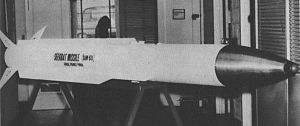This article needs additional citations for
verification. (September 2016) |
| AIM-97 Seekbat | |
|---|---|
 | |
| Type | Air-to-air missile |
| Place of origin | United States |
| Production history | |
| Manufacturer | General Dynamics |
| Specifications | |
| Mass | 1,300 pounds (590 kg) |
| Length | 15 feet (4.6 m) |
| Diameter | 13.5 inches (340 mm) |
| Wingspan | 42.5 inches (1,080 mm) |
| Warhead | Blast-fragmentation |
| Engine | Aerojet MK 27 dual-thrust solid-fuel rocket |
Operational range | 56 miles (90 km) |
| Flight ceiling | 80,000 feet (24,000 m) |
| Maximum speed | > Mach 3 |
Guidance system | Semi-active radar homing (SARH) with terminal infrared homing |
Launch platform | Aircraft |
The AIM-97 Seekbat or XAIM-97A Seek Bat was a long-range air-to-air missile developed by the United States. It was intended to counter the perceived capabilities of the Mikoyan-Gurevich MiG-25 and proposed to arm both the F-15 Eagle and F-4 Phantom, [1] the missile ultimately never entered service.
Overview
In the early to mid-1970s the United States was highly concerned by the perceived capabilities of the MiG-25, an aircraft which was known to be capable of speeds in excess of Mach 3 and which carried long-range air-to-air missiles. [2] It was widely claimed that the Foxbat was a new generation "super-fighter", capable of comfortably outclassing any US or allied aircraft. The US initiated the F-15 Eagle program largely in response to this threat. To equip the F-15 the Air Force initiated development of the AIM-82 short-range missile and the AIM-97 Seekbat. The former was a dogfighting missile intended as a replacement for the AIM-9 Sidewinder, the latter was to be a new high-altitude long-range missile designed specifically to shoot down the MiG-25 - hence the name "Seekbat", the "bat" referring to the MiG-25's "Foxbat" NATO reporting name. [3]
The Seekbat was based on the AGM-78 Standard ARM. It had a larger[ clarification needed] propulsion unit and used semi-active radar homing with an infrared seeker for terminal guidance of the missile. [3] The operational ceiling was 80,000 ft (24,000 m). [2]
Test firings began in late 1972, [a] but the Seekbat program did not make a great deal of progress and was cancelled in 1976. [2] By this time new knowledge of the MiG-25s capabilities and role led to the cancellation of the program because the missile's cost did not justify its procurement.[ citation needed]
See also
References
- Notes
- ^ Thornborough & Davies 1994, p. 140
- ^ a b c Parsch 2002
- ^ a b c Hewish 1974, p. A16
- Bibliography
- Hewish, Mark (1974-03-14). "World Missile Yearbook". Flight International. IPC Transport Press Ltd. Retrieved 2016-09-22.
- Hewish, Mark (1975-05-08). "World Missile Survey". Flight International. IPC Transport Press Ltd. Retrieved 2016-09-22.
- Hewish, Mark (1976-05-29). "World Missiles". Flight International. IPC Transport Press Ltd. Retrieved 2016-09-22.
- Parsch, Andreas (2002). "General Dynamics AIM-97 Seekbat". Directory of U.S. Military Rockets and Missiles. Retrieved 2016-09-20.
- Thornborough, Anthony M.; Davies, Peter E. (1994). The Phantom Story. Arms & Armour Press. ISBN 1-85409-121-2.